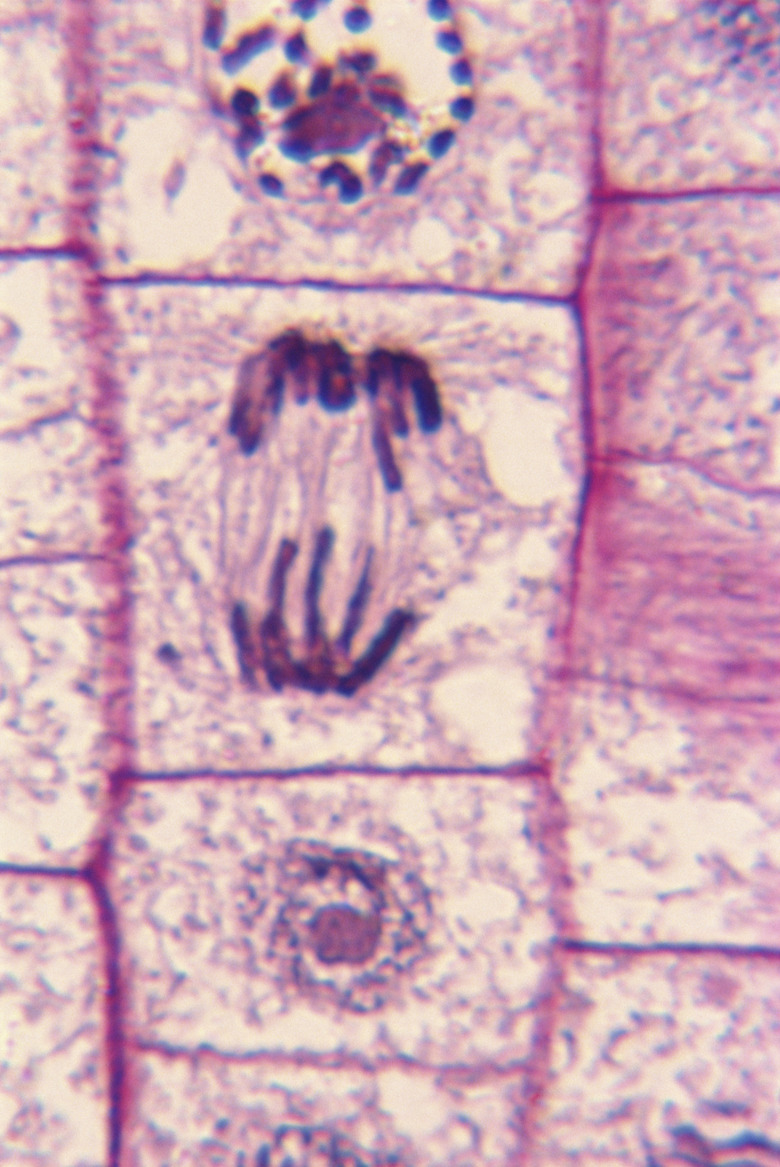The Term "Synapsis" Is Associated With Which Process?
Two basic types of cell division, mitosis and meiosis, occur in plants, animals, protists and fungi.
In animals, mitosis occurs in body cells to produce growth and repair and maintain body tissues. Each daughter cell is a genetic replica of the original cell.
Meiosis occurs in sexual reproduction to generate variable gametes, or eggs and sperm, which unite to form a new individual different from the parents.
Synapsis is the unique way that chromosomes line up in the first division of meiosis, called "meiosis I," so it occurs during meiosis but not during mitosis. Each chromosome pair connects together, often exchanging genetic material between the individual chromosomes. Called crossing over, this exchange is an important way to increase genetic variability in sexually reproducing organisms.
New Genetic Combinations
New Genetic Combinations
Meiosis produces cells with half as many chromosomes as contained in body cells, called a haploid state, so that offspring have the correct number of chromosomes.
In humans, body cells have a diploid, or doubled, number of 46, with 23 pairs of chromosomes. Each pair has a maternal and paternal chromosome, called homologous chromosomes. During meiosis, two divisions occur to produce haploid gametes with 23 single chromosomes.
Each gamete has unique combinations of maternal and paternal chromosomes. This genetic variability is important, so that organisms can adapt to changing conditions. Further genetic variability occurs during synapsis, when genetic material is exchanged between sister chromatids during crossover.
How Synapsis in Meiosis Occurs
How Synapsis in Meiosis Occurs
Before meiosis begins, the homologous pairs of chromosomes contained in the cell's nucleus replicate to form two pair of sister chromatids, each pair held together by structures called centromeres.
To begin meiosis, the nuclear membrane dissolves and the chromosomes shorten and thicken. During this first stage, called prophase I, synapsis occurs. The two pair of sister chromatids connect together along their lengths through combinations of RNA and proteins called the "synaptonemal complex."
The connected chromatids continue to shorten, coiling together in the process. They can interlock to the extent that pieces of sister chromatids break off and become reattached to the opposite chromatid, so that part of the maternal chromatid is now on the paternal chromatid and vice versa.
Called crossing over or "recombination," this process further enriches genetic variability, alongside factors like random fertilization.
Synapsis Ends
Synapsis Ends
As meiosis I continues, during metaphase I the synapsed homologous chromosome pairs migrate to the center of the cell and line up. The maternal and paternal homologous chromosomes can assort randomly to either the left or right side of the cell.
Next, during anaphase I, synapsis ends and homologous chromosome pairs separate and migrate to opposite cell sides. In telophase I, cell division locates one type of each homologous chromosome pair in each haploid daughter cell, with the chromatids carrying crossover genetic material within them.
The Rest of Meiosis
The Rest of Meiosis
In meiosis II, the two cells from meiosis I divide to separate the two sister chromatids of the homologous pairs. The resultant gametes now have a haploid number of unpaired sister chromosomes. In humans, the male gametes are four functional sperm cells. Meiosis in female humans produces one large functional egg and three small (and eventually discarded) cells called polar bodies that contain nuclei but little cytoplasm.
Genetic variability in the gametes comes, first, from the independent assortment of individual chromosomes during each meiotic division with maternal and paternal chromatids scattering throughout the daughter cells in a random fashion. In humans, the total possible combinations of pairing 23 chromosomes is 8,324,608.
The second source of variability comes from the exchange of genetic material from crossover during synapsis.
References
- Online Biology Dictionary: Stages of Meiosis: Prophase I
- University of Miami Health System: Miller School of Medicine: John P. Hussman Institute for Human Genomics: Genetics Basics – Lesson 5: Meiosis
- Genetics: Interlock Formation and Coiling of Meiotic Chromosome Axes During Synapsis
- Palomar College: Recombination and Linkage
Cite This Article
MLA
Csanyi, Carolyn. "The Term "Synapsis" Is Associated With Which Process?" sciencing.com, https://www.sciencing.com/term-synapsis-associated-process-12323259/. 8 March 2019.
APA
Csanyi, Carolyn. (2019, March 8). The Term "Synapsis" Is Associated With Which Process?. sciencing.com. Retrieved from https://www.sciencing.com/term-synapsis-associated-process-12323259/
Chicago
Csanyi, Carolyn. The Term "Synapsis" Is Associated With Which Process? last modified August 30, 2022. https://www.sciencing.com/term-synapsis-associated-process-12323259/
